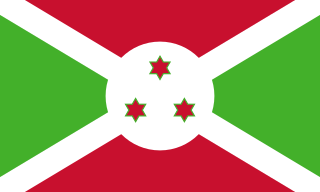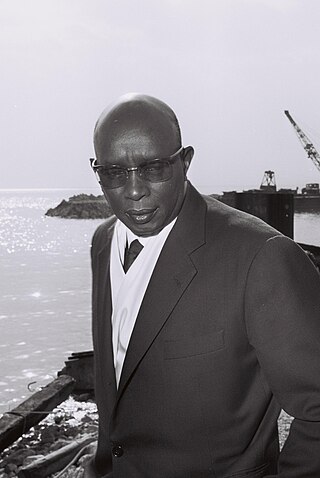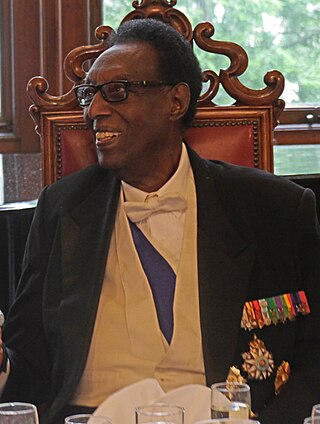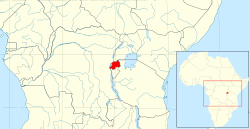
Burundi originated in the 16th century as a small kingdom in the African Great Lakes region. After European contact, it was united with the Kingdom of Rwanda, becoming the colony of Ruanda-Urundi - first colonised by Germany and then by Belgium. The colony gained independence in 1962, and split once again into Rwanda and Burundi. It is one of the few countries in Africa to be a direct territorial continuation of a pre-colonial era African state.
Human occupation of Rwanda is thought to have begun shortly after the last ice age. By the 11th century, the inhabitants had organized into a number of kingdoms. In the 19th century, Mwami (king) Rwabugiri of the Kingdom of Rwanda conducted a decades-long process of military conquest and administrative consolidation that resulted in the kingdom coming to control most of what is now Rwanda. The colonial powers, Germany and Belgium, allied with the Rwandan court.

Mwambutsa IV Bangiricenge was the penultimate king of Burundi who ruled between 1915 and 1966. He succeeded to the throne on the death of his father Mutaga IV Mbikije. Born while Burundi was under German colonial rule, Mwambutsa's reign mostly coincided with Belgian colonial rule (1916–62). The Belgians retained the monarchs of both Rwanda and Burundi under the policy of indirect rule.

Kigeli V Ndahindurwa was the last ruling King (Mwami) of Rwanda, from 28 July 1959 until the end of the UN-mandate with Belgian administration and the declaration of an independent Republic of Rwanda 1 July 1962. On 25 September 1961, a referendum voted for the abolition of the Rwandan monarchy following the Rwandan Revolution.

Mutara III Rudahigwa was King (umwami) of Rwanda between 1931 and 1959. He was the first Rwandan king to be baptised, and Roman Catholicism took hold in Rwanda during his reign. His Christian names were Charles Léon Pierre, and he is sometimes referred to as Charles Mutara III Rudahigwa.

Ruanda-Urundi, later Rwanda-Burundi, was a colonial territory, once part of German East Africa, that was occupied by troops from the Belgian Congo during the East African campaign in World War I and was administered by Belgium under military occupation from 1916 to 1922. It was subsequently awarded to Belgium as a Class-B Mandate under the League of Nations in 1922 and became a Trust Territory of the United Nations in the aftermath of World War II and the dissolution of the League. In 1962 Ruanda-Urundi became the two independent states of Rwanda and Burundi.

The Kingdom of Burundi, also known as Kingdom of Urundi, was a Bantu kingdom in the modern-day Republic of Burundi. The Ganwa monarchs ruled over both Hutus and Tutsis. Created in the 16th century, the kingdom was preserved under German and Belgian colonial rule in the late 19th and early 20th century and was an independent state between 1962 and 1966.

The Party of the Hutu Emancipation Movement, also known as the Republican Democratic Movement – Parmehutu, was a political party in Rwanda. The movement emphasised the right of the majority ethnicity to rule and asserted the supremacy of Hutus over Tutsis. It was the most important party of the "Hutu Revolution" of 1959–61 that led to Rwanda becoming an independent republic and Hutus superseding Tutsis as the ruling group.

Yuhi Musinga was a king of Rwanda who came to power in 1896 and collaborated with the German government to strengthen his own kingship. In 1931 he was deposed by the Belgian administration because of his inability to work with subordinate chiefs and his refusal to be baptized a Roman Catholic. His eldest son, Mutara III Rwanda, succeeded him.

Kigeli IV Rwabugiri was the king (mwami) of the Kingdom of Rwanda in the mid-nineteenth century. He was among the last Nyiginya kings in a ruling dynasty that had traced their lineage back four centuries to Gihanga, the first 'historical' king of Rwanda whose exploits are celebrated in oral chronicles. He was a Tutsi with the birth name Sezisoni Rwabugiri. He was the first king in Rwanda's history to come into contact with Europeans. He established an army equipped with guns he obtained from Germans and prohibited most foreigners, especially Arabs, from entering his kingdom.
Kiga people, or Abakiga, are a Bantu ethnic group native to south western Uganda and northern Rwanda.
These are some of the articles related to Rwanda on the English Wikipedia pages:

The Rwandan Revolution, also known as the Hutu Revolution, Social Revolution, or Wind of Destruction, was a period of ethnic violence in Rwanda from 1959 to 1961 between the Hutu and the Tutsi, two of the three ethnic groups in Rwanda. The revolution saw the country transition from a Tutsi monarchy under Belgian colonial authority to an independent Hutu-dominated republic.

Léon-Paul Classe, M.Afr. was a Catholic priest who was Vicar Apostolic of the Apostolic Vicariate of Ruanda, in what is now Rwanda, from 1922 until his death in 1945. During his time as a missionary priest and then bishop a great many Rwandans were converted to Christianity. Classe was influential in persuading the Belgian colonial administration to favor the Tutsis as a ruling caste in the country over the Hutu majority.
Michel Rwagasana was a Rwandan politician who served as secretary general of the Union Nationale Rwandaise (UNAR) and represented Nyanza in the Rwandan Legislative Assembly from 1961 to 1963. Born to Hutu and Tutsi parents in Ruanda-Urundi, Rwagasana worked for the colonial administration and advised King Mutara III Rudahigwa of Ruanda before cofounding UNAR, a Tutsi-dominated monarchist political party. UNAR lost out to the majority party, Parmehutu led by Rwagasana's cousin Grégoire Kayibanda, but supported the integration of UNAR into a coalition government as the country became independent as the Republic of Rwanda. He was killed in a purge in 1963, and is currently recognized by the Rwandan government as a national hero.

Belgium-Rwanda relations refers to the international and diplomatic relations between Belgium and Rwanda. Belgian relations with Rwanda started under the League of Nations mandate, when the modern day countries of Rwanda and Burundi were governed as Ruanda-Urundi. As the colonial power, Rwanda's relationship with Belgium has been significant throughout the country's history, even after independence.
François Rukeba was a Rwandan politician and rebel leader.
Prosper Bwanakweli was a Rwandan chieftain and politician.
In the Rwandan Revolution, the coup of Gitarama was an event which occurred on 28 January 1961 in which the monarchy in Rwanda, then a part of the Belgian mandate of Ruanda-Urundi, was abolished and replaced with a republican political system. The traditional monarchy was led by a Mwami (king), who ruled through an administration of chiefs and subchiefs in the context of a feudal system of patron-client relations based on tribute. The Mwami and most of his chiefs were members of the Tutsi ethnic minority, a group which wielded considerable social, political economic power. Of subordinate status to the Tutsis was the Hutu ethnic majority. As part of their rule, the Belgians institutionalised a racial hierarchy which favoured the Tutsis at the expense of the Hutus.
















